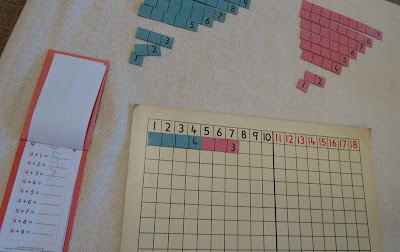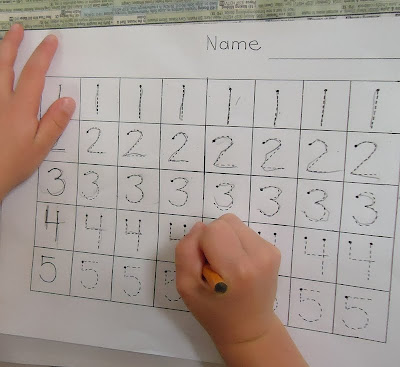Look what I found in my draft files! I am so excited to share this especially after my recent post about Montessori Floor Scrubbing, which you can find
here. The exercises of Practical Life are so essential to the harmony of the classroom and I find it inspiring that even now, at the end of the school year, these lessons play a vital role in the children's days at school.
__________________________________________________________________________________
I often get the feeling while speaking about my Montessori classroom, that generally, people need to know more about the Practical Life activities. Too many times, it appears to be glossed over in parent discussion while topics of Language and Math materials generate more interest. For this reason, I wish to share additional information regarding the critical significance of the Montessori Practical Life exercises.
The Montessori classroom is a meticulously prepared environment designed specifically to meet the needs of the child both physically and emotionally. One aspect of the prepared environment includes the Practical Life activities. Many Practical Life activities are tasks the child sees routinely performed in the home. They each serve a meaningful purpose as the child masters each piece of work such as tying shoes, pouring water, sweeping, or sewing and cooking. Through Practical Life activities, a child will also develop and refine social skills. These skills developed through Practical Life build self-esteem, determination and independence.
The student learns to take care of himself and the surrounding environment. Maria Montessori explains in, The Discovery of the Child, “Through practical life exercises of this sort the children develop a true ‘social feeling,’ for they are working in the environment of the community in which they live” (5, pg. 97). Additionally, fine motor skills are improved through use of the Practical Life materials. Through repeated tasks which enable a child to refine concentration, coordination, independence, and order, a child’s sense of self-worth grows. The Practical Life skills are an essential component in the Montessori classroom. Not only do they provide a link between home and school for the new Montessori student, but they provide a foundation for life-long love of learning.
While appearing quite simple and repetitive, Practical Life activities are highly purposeful. A child engaged in such activities demonstrates high levels of concentration, sense of order, and refinement of fine motor skills. Also, they show a sense of independence through caring for oneself and the environment. Furthermore, they show respect for classmates and teachers and develop a sense of pride. Not only are these skills and qualities necessary to progress in the Montessori classroom, but they are also needed as an individual develops into adulthood.
Practical Life activities can be divided into six main categories. First, are Preliminary Exercises which assist in creating routine and order in the environment and are prerequisites for other activities. How to a roll a mat, carry a chair, or how to open and close a door are examples of Preliminary Exercises. Practical life exercises also include Fundamental Skills such as pouring, spooning, or tonging. As with all lessons in the Montessori classroom, these activities follow a sequential order and ideally, each lesson builds upon the last. Another category is Care of Self. Activities such as washing hands, buttoning, or tying shoelaces assist the child to become physically independent. Care of Environment is another category involving activities such as sweeping, watering, cleaning, etc. Control of Movement is an area of Practical Life which encompasses lessons such as Walking the Line and the Silence Game. Additionally, social Grace and Courtesy lessons are introduced to the child. These may include lessons on how to say please and thank you, interrupting someone, or introducing friends and acquaintances. Montessori stressed the relationship of these exercises to the general happiness and well being of the child. “A child who becomes a master of his acts through long and repeated exercises [of practical life], and who has been encouraged by the pleasant and interesting activities in which he has been engaged, is a child filled with health and joy and remarkable for his calmness and discipline” (The Discovery the Child, 5, pg. 93).
Varying types of presentations can be used by the teacher to introduce Practical Life activities. First is a collective introduction given the children at once. This could include proper table manners, how to interrupt someone, how to speak with an inside voice, or how to turn the page of a book. Another method is a group presentation given to a small gathering of children. The last method of introduction is Individual, given only to one child at a time.
Montessori believed the prepared environment is directly correlated to the child’s development. The classroom is a specifically designed area arranged solely for the children. There should be a variety of movement and activity and all work operates together through the disciplines. Montessori also believed in the importance of aesthetically pleasing classrooms. Children respond well to beauty, order, and quality in their environment.
Through the Practical Life activities in the Montessori classroom, a child not only learns concentration, coordination, independence and order, but also how to interact with others and gain an understanding and appreciation of the environment. The child begins to build himself from within while learning to treat himself and others with respect and dignity. These understandings ultimately prepare the child for entry into society and a lifetime of self-respect and self-worthiness. Practical Life activities in the Montessori classroom ultimately provide the foundation for success in all areas of life.
Below are some photos of the Practical Life areas in my classroom:
 |
| Handwashing Table |
 |
| Dry Transferring (set up with a Winter theme). |
 |
| Wet Transferring (set up with a Fall theme). |
 |
| Polishing Materials - top: Leather Polishing; middle: replenishables (cotton balls, q-tips, polishing cloths); bottom from left to right: Metal Polishing (red), Glass Polishing (blue), and Wood Polishing (yellow). |
 |
| Care of Environment supplies - top: Cleaning up a spill (orange); Window Washing (green); bottom: Washing the Easel (blue) which can also be for table and chair washing... |

















































